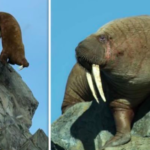There are few places left on the map today that haven’t already been explored and greatly documented down to the last detail. But there’s still the Great Blue Hole right off the coast of Belize, which is a deep blue marine sinkhole surrounded by a coral atoll and clear waters, which remains an explorer’s paradise. Exploring this geological oddity has been a dream-turned-reality for an expedition team comprised of scientists, filmmakers, Richard Branson, and Fabien Cousteau, the grandson of famed French explorer Jacques Cousteau who first brought the Blue Hole to notoriety in the early 1970s.
The team gathered many scientific insights, as well as stunning photographs, but they came across something else more sinister when exploring the bottom of the sinkhole: bodies of previous divers.
Erika Bergman, National Geographic Explorer and submarine pilot, told Newsweek, “Mostly it was quiet and dark down there. We also encountered the resting place for two of the divers who’ve been lost in the hole. We notified the local authorities, and everyone agreed to leave them undisturbed. They are at peace.”
It’s unclear how many people may have died over the years while trying to explore the sinkhole. However, Bergman also informed Business Insider that the diving pair are believed to be two of the three people known to have been lost to the sinkhole. At this time it’s not quite clear who these divers were or how they died.
The Great Blue Hole is over 984 feet wide and 410 feet deep, making it the world’s second-largest marine sinkhole right after the Dragon Hole in the South China Sea. Marine sinkholes are a result of the past ice ages, and for the most part, they were an ancient grouping of limestone caves. As sea levels rose by hundreds of feet during the last glacial period around 14,000 years ago, the limestone beds would dissolve and collapse, flooding the cave with seawater. In this recent expedition, evidence showed that you can still see stalactites lining the inside walls of the hole. It’s the same as you would see in a normal cave today.
The further you go into the sinkhole, the environment gets even more inhospitable, with a layering of hydrogen sulfide depriving the water of oxygen below the depth of 300 feet. The hydrogen sulfide itself is a very corrosive and toxic substance, and as a result, the bed of the sinkhole has become a graveyard to certain marine life.
“Presumably, unsuspecting conchs (or other conch shell inhabitants) have been going just a little too close to the edge and falling into the hole at this entrance by the thousands. We can see each conch with little tracks back up the hill trying to escape, then a slide mark where it slid back down after presumably being asphyxiated in the anoxic environment,” Erika wrote in a post on a blog.
Sounds like a very mysterious place to explore. What do you think of the Blue Hole?
h/t: IFLScience






